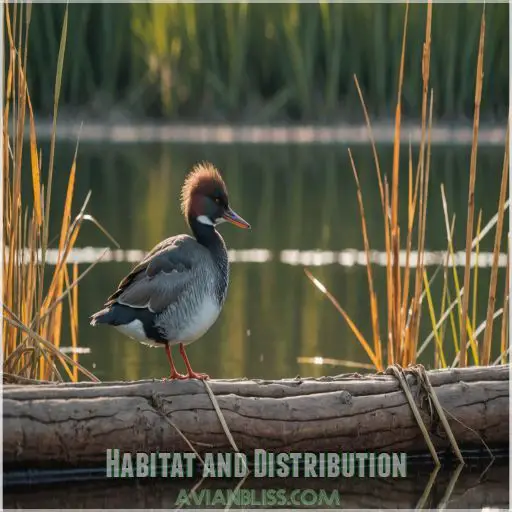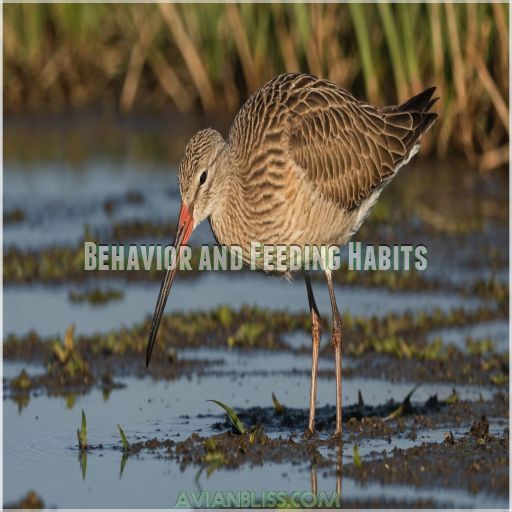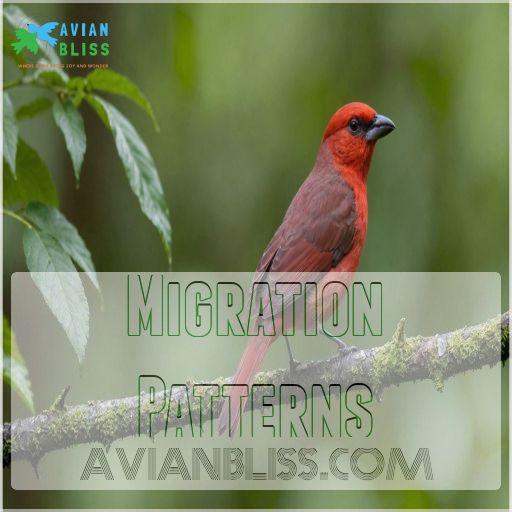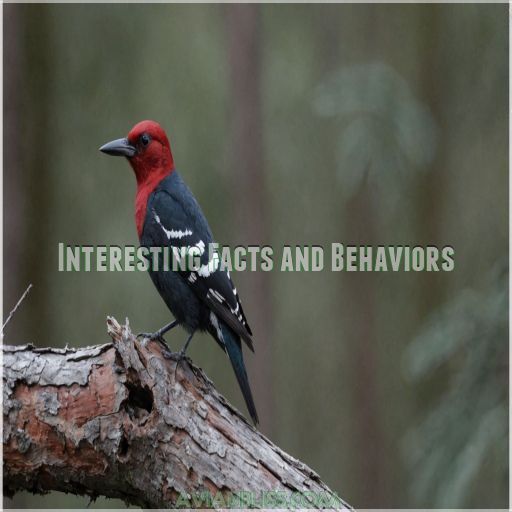This site is supported by our readers. We may earn a commission, at no cost to you, if you purchase through links.

With their slightly upturned bills and buff-brown plumage, they’re like the supermodels of the shorebird world. These clever birds use their long beaks to probe deep into mud for tasty treats, making them the ultimate beach combers.
During breeding season, they trade sandy shores for grassy prairies, where they perfect the art of camouflage. But there’s more to these feathered globetrotters than meets the eye – their journey is full of surprises.
Table Of Contents
- Key Takeaways
- Physical Characteristics
- Habitat and Distribution
- Behavior and Feeding Habits
- Migration Patterns
- Nesting and Reproduction
- Conservation Status and Threats
- Comparison With Other Godwit Species
- Interesting Facts and Behaviors
- Frequently Asked Questions (FAQs)
- Why are marbled godwit endangered?
- What is the difference between marbled Godwit and bar-tailed godwit?
- Where do Marbled Godwits migrate?
- What is the difference between marbled Godwit and long billed curlew?
- How long do marbled godwits live on average?
- Do marbled godwits exhibit oversummering behavior?
- At what age do marbled godwits first breed?
- How do marbled godwits cope with habitat loss?
- What are the main predators of marbled godwits?
- Conclusion
Key Takeaways
- You’ll be amazed by the marbled godwit’s epic road trips, covering up to 1,850 miles annually from Mexico to the northern prairies. These feathered globetrotters are like the supermodels of the shorebird world, with their cinnamon wings and slightly upturned bills perfect for probing mud like a custom-designed spatula.
- While watching these birds, you’ll notice they’re masters of adaptation. They’ve bounced back from near extinction in the 19th century, but they’re not out of the woods yet. Climate change and habitat loss are giving them a run for their money, but these cinnamon-colored warriors aren’t throwing in the towel just yet.
- You’ll find that marbled godwits are the social butterflies of the bird world. They love a crowd, often forming flocks of hundreds during migration. It’s like they’ve got their own frequent flyer club! These clever birds are adjusting their migration timing and breeding seasons to sync with shifting food sources, proving they’re nature’s ultimate survivors, much like the cardinals’ nesting habits that are influenced by food availability
.
- As you explore their world, you’ll discover that protecting marbled godwits isn’t just about saving a species – it’s about preserving a living example of the power of perseverance. By safeguarding wetlands and prairies, you’re helping to write the next chapter in their incredible story. Remember, their future is in your hands!
Physical Characteristics
When you spot a Marbled Godwit, its impressive size and warm brown plumage are hard to miss.
With a bill that’s slightly upturned and shows a hint of pink, it might remind you of a Long-billed Curlew, but trust me, that curvy tool is uniquely Godwit.
Description and Identification
Identifying a Marbled Godwit, or Limosa fedoa, isn’t as hard as finding Waldo on a crowded page. Picture a large wading bird with warm cinnamon plumage, perfect for blending into prairie grasslands or coastal shores.
Like dabbling ducks such as the Gadwall’s wetland habitats, Marbled Godwits are partial to open water areas with grass and shrubs. They can also be found in other habitats with shallow water, such as marshes and small ponds.
- Size: About crow-sized
- Plumage: Cinnamon wings with brown barring
- Bill: Long, slightly upturned
- Habitat Clues: Grassland and coastal bird habitats
- Lookalikes: Similar to Long-billed Curlew.
Bill Shape and Size
The Marbled Godwit’s unique bill, slightly upcurved and pink at the base, serves as a precision tool for feeding.
It’s like a custom-designed spatula, perfect for probing deep into the mud for mollusks and invertebrates.
This clever adaptation reflects their role as skilled foragers, making them superb at exploiting their geographic range’s resources during their life history .
Plumage and Coloration
That long, slightly upturned bill isn’t the marbled godwit’s only claim to fame. Sporting rich buff-brown feathers with intricate bars, these birds flaunt cinnamon wing linings that steal the show.
Seasonal variations introduce molting patterns, with juveniles showing subtler hues.
Such brilliant coloration aids camouflage at breeding grounds and wintering grounds, making them NatureServe’s masters of disguise .
Similarities With Long-billed Curlew
Ever noticed how marbled godwits and long-billed curlews share striking similarities?
They both sport long, elegant bills perfect for probing the mud, though the curlew’s is more dramatically curved.
These migratory birds often share wetlands during their journeys across North America, but each has its quirks, including those that exhibit remarkable Arctic bird patterns
.
Despite their overlap, conservation concerns hover due to habitat loss.
Habitat and Distribution
Marbled godwits are true globetrotters, breeding on the northern Great Plains and migrating to coastal regions as far south as South America for the winter.
From open prairies to tidal mudflats, these adaptable shorebirds thrive in a variety of habitats across their expansive range.
Breeding Grounds and Summer Range
Imagine this: You’ve got Marbled Godwits nesting harmoniously on the sweeping prairies of North America. These prairie birds thrive in grasslands with nearby wetlands during the breeding season.
Their success isn’t guaranteed, though. Consider these factors:
- Climate Impact: Changes threaten their breeding grounds.
- Habitat Loss: Conversion to farmland squeezes space.
- Nesting Success: Relies on Nature Serve’s protection.
Wintering Grounds and Migration Patterns
When spring turns to fall, Marbled Godwits set out on their great migratory journey, embracing the call of coastal mudflats and sandy beaches.
Often seen at stopover sites like the Great Salt Lake and Bear River Migratory Bird Refuge , these birds follow precise migration routes, avoiding threats and employing their unique ‘hopping’ strategy, a part of their great migratory journey.
Preferred Habitats and Vegetation
Marbled godwits love grassland vegetation, favoring shortgrass prairies for nesting.
They shun tall plants like the cat avoids water, choosing spots near wetlands of green needle grass and little blue stem.
During seasonal changes, they shift to coastal mudflats and beaches, dining on their preferred food sources such as aquatic invertebrates and small fish.
Regional Variations in Habitat
In Godwits’ world, habitat preferences vary like a fashion trend.
These birds favor prairies with sparse vegetation for breeding success, avoiding the dense stuff.
In winter, coastal mudflats steal the show, offering prime food sources.
Yet, threats like habitat loss loom large, challenging their adaptable spirit.
As they wing it, they’re true masters of regional adaptation .
Behavior and Feeding Habits
Imagine you’re wading through peaceful wetlands, where Marbled Godwits expertly probe mud and water in search of tasty treats like insects and mollusks.
These skilled foragers rely on their unique, slightly upturned bills to uncover food, demonstrating both ingenuity and hard work in every meal.
Foraging Techniques and Prey
A marbled godwit’s long, slightly up-curved bill is perfect for mud probing and finding prey (Source).
Their diet’s as diverse as a buffet: Aquatic invertebrates like shrimp and crabs. Earthworms from damp soil. Small fish swimming near shore. Insects hiding in wet grass.
These strategies help them thrive amidst food competition and seasonal variation.
Feeding Grounds and Migration Patterns
You’ve marveled at their foraging skills; now explore Marbled Godwits‘ perilous journey!
These shorebirds stop over in lush wetlands to refuel, fine-tuning their migration timing to exploit food-rich habitats.
Climate impact and habitat changes can disrupt their rhythm, making survival a high-stakes dance with nature’s whims.
Their resilience? Admirable, isn’t it? It’s an Admirable trait that is not only impressive but also worthy of note.
Social Structure and Territorial Behavior
Imagine the marbled godwit as a passionate dance partner in nature’s waltz.
They balance solitude and camaraderie, claiming large territories with both grace and gusto.
During breeding season, their social hierarchy emerges through amusing mating rituals and spirited territory defense, while flock dynamics highlight teamwork in bustling colonies.
This blend of independence and belonging makes them unique, showcasing their ability to thrive in a delicate balance of independence and belonging .
Unique Feeding Adaptations
As marbled godwits patrol their territories, they’ve got some remarkable feeding tricks up their sleeves.
Let’s chat about those:
- Their long, upturned bill is perfect for probing techniques, sensing mud, and unearthing hidden snacks.
- They exhibit adaptive foraging by targeting aquatic invertebrates.
- Not picky eaters, their food preferences include earthworms, small fish, and even plant tubers.
Migration Patterns
As a passionate birder or curious explorer, you’ll love uncovering the marbled godwit’s migration secrets.
From whirlwind fall journeys to springtime returns, there’s no shortage of marvels in their seasonal routes and awe-inspiring stopovers.
Fall Migration Routes and Timing
Picture marbled godwits setting off on their fall migration, facing challenges and stopover locations like travelers on a road trip.
They leave northern prairies, heading to coastal wintering grounds.
Their routes may not rival Bar-tailed Godwits, but these godwits rely on precise timing and clever adaptations to find safe harbors during their journey.
Spring Migration Routes and Timing
Spring migration for Marbled Godwits kicks off as they’re drawn north by nature’s call, with timing varying due to weather whims.
These shorebirds fly from Mexico to breed in northern prairies and Canada, covering impressive distances.
Their journey’s a marvel, brimming with challenges, yet they push through, determined to reach their beloved breeding grounds.
Stopover Sites and Refueling
During migration, Marbled Godwits make strategic pit stops at key refueling sites.
You’ll find these long-billed waders touching down at:
- Coastal mudflats teeming with juicy invertebrates
- Salt ponds buzzing with brine shrimp
- Estuaries rich in marine life
- Sandy beaches with hidden morsels
These stopover havens aren’t just fast-food joints; they’re five-star restaurants where godwits can pack on the pounds. Refueling is critical for these feathered marathoners, as they need to build up energy reserves for the next leg of their incredible journey.
Regional Variations in Migration
You’ll find that marbled godwits don’t all follow the same playbook in terms of migration. These savvy travelers adapt their journeys based on where they’re starting from and where they’re headed.
Let’s take a look at how their routes and timing can differ:
| Region | Spring Migration | Fall Migration |
|---|---|---|
| Pacific Coast | Early April | Late June-Sept |
| Great Plains | Mid-April | July-August |
| Great Lakes | Late April | August-September |
| Atlantic Coast | Early May | September-October |
These regional differences showcase the godwits’ flexibility in response to local conditions and food availability.
Nesting and Reproduction
You’re about to discover the fascinating nesting and reproductive habits of the marbled godwit.
From their unique ground nests to their dedicated parenting, these shorebirds have some surprising tricks up their feathered sleeves in terms of raising the next generation, showcasing their dedicated parenting and unique ground nests.
Breeding and Nesting Habits
After their long journey, Marbled Godwits get down to business on the breeding grounds.
These prairie-loving birds aren’t fussy about their nesting spots – they’ll plop their eggs right on the ground in shortgrass prairies. Talk about a no-frills approach!
They typically lay 3-5 eggs in a shallow depression, often lined with grasses and lichen.
It’s a family affair, with both parents sharing incubation duties for 23-26 days.
Mate Selection and Pair Bonding
Marbled Godwits take their love lives seriously. When it comes to mate selection, these birds pull out all the stops. You’ll find them engaging in elaborate courtship rituals and mating displays that would put even the most romantic human to shame.
Their pair fidelity is impressive, with couples often sticking together for multiple breeding seasons.
Territory defense becomes a team effort, as pairs work together to protect their nesting grounds and boost their breeding success.
Egg-laying and Incubation
In the midst of their incredible journey, Marbled Godwits settle down to start families. These remarkable birds lay their eggs in carefully chosen nesting sites, typically on hummocks surrounded by sedges and grasses.
- Clutch size: Usually 5 eggs, laid every other day
- Egg appearance: Ovate pyriform shape, with varying colors and speckles
- Incubation period: About 30 days, starting after the 4th or 5th egg is laid
Chick Development and Fledging
You’ll be amazed at how quickly marbled godwit chicks develop. Within days of hatching, these little balls of fluff are up and about, exploring their surroundings.
They’re born with their eyes open and ready to learn. Like most shorebirds, they’re precocial, meaning they can walk and feed themselves soon after hatching.
But don’t worry – mom and dad are always nearby, keeping a watchful eye out for predators.
Conservation Status and Threats
You might be surprised to learn that the graceful Marbled Godwit has faced some serious challenges throughout history.
While these impressive shorebirds have bounced back from near-extinction in the 19th century, they’re not out of the woods yet.
Habitat loss, climate change, and other threats continue to keep conservationists on their toes.
Historical Decline and Recovery
After the nesting season, marbled godwits faced a dark chapter in their history.
Hunting pressure and habitat loss pushed these elegant shorebirds to the brink.
But here’s the silver lining: conservation efforts have helped them stage a comeback.
Like a phoenix rising from the ashes, marbled godwit populations have shown signs of rebounding. However, their journey to recovery is far from over.
Current Population Trends and Threats
Despite historical recovery efforts, Marbled Godwits still face significant challenges.
Current population trends show a moderate decrease in Canada, with high reliability in this assessment.
The species remains on conservation priority lists, including the USFWS Birds of Conservation Concern .
Climate change, hunting pressure, and oilfield contamination pose ongoing threats.
Conservation efforts are essential, as the estimated global population of 173,500 birds is relatively small and vulnerable.
Habitat Loss and Fragmentation
Habitat loss and fragmentation pose significant threats to the marbled godwit’s survival.
Agricultural expansion and urban sprawl are gobbling up vast swaths of grassland, leaving these iconic birds with fewer places to call home (Source).
It’s like watching your favorite childhood playground slowly disappear, piece by piece.
The godwits’ predicament mirrors that of other grassland species, such as the chestnut-collared longspur.
As you explore the prairies, you’ll notice the landscape changing rapidly.
Climate Change and Sea-level Rise
Climate change is casting a long shadow over the marbled godwit’s future.
You’ll find these resilient birds facing a perfect storm of challenges: rising sea levels are swallowing up their coastal habitats , while saltwater intrusion threatens their breeding grounds.
As storms become more severe, the godwits’ favorite hangouts – tidal mudflats and sandflats – are at risk.
It’s a tough break for these cinnamon-colored warriors, but they’re not throwing in the towel just yet in this tough break.
Comparison With Other Godwit Species
You might be wondering how to tell a Marbled Godwit apart from its feathered cousins.
Let’s explore the key differences between this long-billed beauty and other godwit species, focusing on their unique features and where you’re likely to spot them, particularly the differences that set it apart in its unique features.
Differences From Bar-tailed Godwit
You’ll find the Marbled Godwit’s differences from its cousin, the Bar-tailed Godwit, quite fascinating.
While both sport long, upturned bills, the Marbled Godwit’s is slightly longer and more bicolored . Its cinnamon underwing coverts are a dead giveaway in flight.
Unlike the Bar-tailed’s white rump, the Marbled Godwit lacks this feature. You’ll also notice it’s larger overall, with longer legs that give it a distinctive silhouette.
Distinctive Characteristics and Identifiers
Marbled Godwits stand out from their cousins with some tell-tale signs.
You’ll spot their slightly upturned bicolored bill, cinnamon underwing coverts, and distinctive cinnamon-washed underparts when not breeding. They’re larger than Bar-tailed Godwits, with longer necks and legs.
In flight, look for that uniform wing pattern without the white wingstripe of other godwits . These unique features make Marbled Godwits the fashionistas of the shorebird world. They are also distinguishable by their uniform wing pattern.
Regional Variations in Species Distribution
Godwits aren’t just globetrotters; they’re regional specialists too! When comparing marbled godwits to their feathered cousins, you’ll notice some fascinating distribution patterns.
Let’s break it down:
- Breeding grounds: Marbled godwits prefer northern prairies
- Wintering hotspots: Coastal areas are their go-to
- Range expansion: They’re increasing in Washington state
- Subspecies variations: Both fedoa and beringiae likely visit Washington
It’s like they’ve got their own birdie zip codes!
Interesting Facts and Behaviors
You’re about to discover some fascinating aspects of the marbled godwit’s life that’ll make you appreciate these remarkable birds even more.
From their incredible navigation skills to their clever adaptations for survival, these shorebirds have some tricks up their feathered sleeves that might surprise you.
These shorebirds, with their clever adaptations, have evolved to thrive in their environment.
Long-distance Migration and Navigation
As you track the Marbled Godwit’s journey, you’ll notice their impressive long-distance migration.
With innate navigation strategies, they travel from breeding grounds in the Great Plains to wintering grounds in Mexico, stopping at key locations along the way , traveling over 9,000 miles each year, showcasing their innate navigation strategies.
Social Structure and Flocking Behavior
You’d be amazed at how sociable these long-legged travelers are!
Marbled godwits love a crowd, often forming flocks of hundreds during migration (Source). They’re not just fair-weather friends either – these birds stick together through thick and thin.
Whether they’re foraging for tasty morsels or soaring through the skies, godwits prefer strength in numbers. It’s like they’ve got their own frequent flyer club!
Adaptations for Survival in a Changing Environment
In the face of a rapidly changing world, marbled godwits are true masters of adaptation.
You’ll be amazed by their resilience as they navigate climate change impacts and habitat loss . These clever birds are adjusting their migration timing and breeding seasons to sync with shifting food sources.
They’re even exploring new stopover sites to refuel during their incredible journeys. It’s like they’re nature’s ultimate survivors, constantly evolving to thrive in our ever-changing environment, making them nature’s ultimate survivors.
Frequently Asked Questions (FAQs)
Why are marbled godwit endangered?
Habitat loss threatens, populations decline, yet hope remains.
You’ll find these birds facing challenges from prairie conversion to farmland. They’re not currently endangered, but their numbers have decreased since the 19th century market hunting days.
What is the difference between marbled Godwit and bar-tailed godwit?
Bar-tailed godwits have shorter legs and longer wings than marbled godwits.
You’ll notice their white underbelly and streaked neck, contrasting with marbled godwits’ barred underparts.
Their underwing pattern also differs, sporting black axillaries with a white wingbar.
Where do Marbled Godwits migrate?
From prairie to coast, these cinnamon-colored wanderers set out on a remarkable journey.
You’ll find Marbled Godwits breeding in the northern Great Plains, then wintering along coastal regions.
They’re hoppers, migrating shorter distances—often just a few hundred miles—between stops, which are often just a few hundred miles, and are hoppers
What is the difference between marbled Godwit and long billed curlew?
You’ll spot the difference in their bills right away.
Marbled Godwits have slightly upturned, bicolored bills, while Long-billed Curlews boast longer, downward-curving beaks.
Godwits are smaller, with cinnamon-washed underparts and barred patterns when breeding.
How long do marbled godwits live on average?
While precise data is limited, these fascinating shorebirds can live quite long.
They’re built for endurance, with some individuals potentially reaching up to 29 years old, rivaling their cousin, the Marbled Godwit.
Do marbled godwits exhibit oversummering behavior?
Research suggests some shorebirds exhibit oversummering behavior, staying in non-breeding areas during their first summer.
This likely applies to marbled godwits too, as they’re part of the godwit family that shows delayed maturity.
You’ll find these "teenage" birds, also known as "sub-adults" in some contexts, chilling in wetlands, skipping their first potential breeding season.
At what age do marbled godwits first breed?
Breeding age isn’t explicitly stated in the provided information.
However, most shorebirds reach sexual maturity around 1-2 years old.
You’d likely see marbled godwits first breeding at this age, following their migration patterns and habitat preferences.
How do marbled godwits cope with habitat loss?
You’ll find these resourceful birds adapting to change by seeking out alternative nesting sites.
They’re shifting to less-disturbed grasslands and even agricultural fields.
Conservation efforts focus on protecting remaining prairie habitats and creating suitable wetland areas for their survival.
What are the main predators of marbled godwits?
Imagine a delicate balance in nature’s grand tapestry.
You’ll find that these graceful shorebirds face threats from above and below.
Aerial predators like hawks and falcons, as well as ground-based hunters such as foxes and coyotes, keep godwits on their toes due to the presence of aerial predators.
Conclusion
Marveling at the marbled godwit’s magnificent migrations, you’ve witnessed the wonders of these winged wanderers.
From their cinnamon-hued plumage to their epic journeys, these shorebirds showcase nature’s ingenuity.
As you reflect on their incredible adaptations and resilience, remember that the marbled godwit’s story is far from over.
Their future depends on our stewardship of their habitats. By protecting wetlands and prairies, you’re not just saving a species – you’re preserving a living example of the power of perseverance and the beauty of the natural world.











